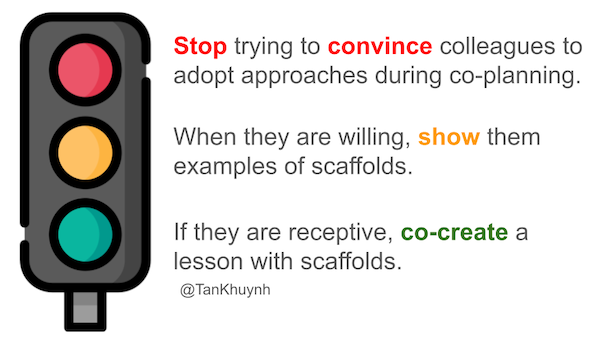The Traffic Lights of Teacher Collaboration
A MiddleWeb Blog
 The question I receive the most from fellow English language development (ELD) colleagues regarding teacher collaboration is “What can we do when our co-teacher is resistant to collaborating?”
The question I receive the most from fellow English language development (ELD) colleagues regarding teacher collaboration is “What can we do when our co-teacher is resistant to collaborating?”
When I first started collaborating with fellow teachers on behalf of multilingual learners (MLs), I would spend most of my cognitive and emotional resources trying to convince them to adopt scaffolds for MLs.
There are many problems with this antagonistic approach. If I am trying to convince a colleague to adopt a strategy, the implicit message is that they are not effective as a teacher.
This approach often produced tension in our relationship and placed barriers in the way of future collaboration.
After years of trying new approaches and analyzing what works best, I’ve realized that I was trying to improve my skill set in a sport that I wasn’t supposed to be playing in the first place. I thought that if I improved my persuasiveness while co-planning lessons, I would improve the instruction by convincing my colleague to adopt my suggestions. It was a game plan that seldom worked.
Red light
Upon this realization, I started developing a “traffic light” framework when collaborating with colleagues. When a colleague was unwilling to collaborate, that was a red light, and I heard that as a not yet. I then devoted my efforts to supporting MLs the best way I could. This typically meant helping students successfully understand the content and engage with the assignment, even if it is not as ML-friendly as it could be.
For example, if students were assigned a research project, I would sit with a group of MLs and guide them as they searched for resources and processed the ones they found. Supporting MLs is not about a co-teaching model as much as meeting the learning need that arises.
Yellow light
When a colleague is somewhat willing to collaborate, that’s a yellow light for collaboration. This indicates that my colleague needs me to show them how a particular lesson might be scaffolded. The hesitation comes from lack a of familiarity with when and how to implement a particular scaffold. To ease their hesitation, I often share a scaffold that I used previously in another class for them to see the scaffold at work.
For example, I shared with an art teacher how we could use a list of prompts to make the instructions clearer – a method I had implemented successfully in a social studies class. We then worked together to see how we could implement this approach to their specific context.
Green light
A green light for collaboration means my colleague is highly receptive to designing instruction specifically for MLs. When I find myself working with this type of colleague, we spend more time co-creating the scaffold and less time trying to debate if scaffolding is appropriate.
Constructing a scaffold together is far more successful than if I just “give” them a scaffold. If we co-create something simultaneously, we are better able to align the scaffold to my colleague’s style and the lesson’s requirements. For example, if my colleague is interested in scaffolding a report, we might spend time writing an outline with specific prompts to guide students’ writing.
When we co-plan synchronously this way, the teacher leaves with a scaffold they feel comfortable using with MLs because they co-created it. There’s instantly more buy-in from the colleague because they shaped this scaffold to fit their lesson.
I leave the co-planning session knowing that I met the instructional needs of MLs. Additionally, we both leave feeling affirmed because our contributions were valued. This means that the pathway for future collaboration has opened wider.
Making traffic lights work for MLs
My suggestion to my fellow ELD teachers is to lean more into opportunities where collaboration is possible and stop insisting that our more resistant colleagues adopt our practices. Patiently look for signs that they are ready. In the meantime, be at ease with knowing that you can still be of service to MLs by meeting the needs that arise today.
In the end, we will realize how enjoyable it is to devote ourselves to an approach that puts the needs of MLs first, whatever color the traffic light may be.































What to do if colleagues differ in fundamental matters related to the philosophy of teaching and learning?
Hola, Jorge.
Thanks for your comment. That scenario falls under “red”. When that happens, we just serve the educational need that arises despite our differences. For example, if a person likes to lecture, you can write notes on the board as they are lecturing.
Interesting article. I am trying to translate, no pun intended (really), into management of our small business. Change can be hard to do. Thank you!